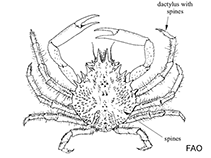Macrocheira kaempferi Temminck, 1836
Japanese giant spider crab| Native range | All suitable habitat | Point map | Year 2050 |

|
| This map was computer-generated and has not yet been reviewed. |
| Macrocheira kaempferi AquaMaps Data sources: GBIF OBIS |
Google image | No image available for this species;
drawing shows typical species in Majidae.
Classification / Names Common names | Synonyms | CoL | ITIS | WoRMS
Malacostraca | Decapoda | Majidae
Environment: milieu / climate zone / depth range / distribution range Ecology
Benthic; depth range 50 - 400 m (Ref. 99853), usually 50 - 200 m (Ref. 99852). Subtropical
Distribution Countries | FAO areas | Ecosystems | Occurrences | Introductions
Northwest Pacific: Japan and Taiwan.
Length at first maturity / Size / Weight / Age
Maturity: Lm ? range ? - ? cm Max length : 30.0 cm CW male/unsexed; (Ref. 343); max. published weight: 13.6 kg (Ref. 99323)
Life cycle and mating behavior Maturity | Reproduction | Spawning | Eggs | Fecundity | Larvae
Main reference
References | Coordinator | Collaborators
Tanase, H. 1967 Preliminary notes on the zoea and megalopa of the giant spider crab, Macrocheira kaempferi de Haan. Publ. Seto Mar. Biol. Lab. XV(4):303-309. (Ref. 99852)
IUCN Red List Status
(Ref. 130435: Version 2025-1)
CITES status (Ref. 108899)
CMS (Ref. 116361)
Threat to humans
Human uses
| FishSource |
Tools
More information
Diet composition
Food consumption
Predators
Max. ages / sizes
Length-weight rel.
Length-length rel.
Length-frequencies
Mass conversion
Abundance
Internet sources
BHL | BOLD Systems | CISTI | DiscoverLife | FAO(Publication : search) | Fishipedia | GenBank (genome, nucleotide) | GloBI | Gomexsi | Google Books | Google Scholar | Google | PubMed | Tree of Life | Wikipedia (Go, Search) | Zoological Record



